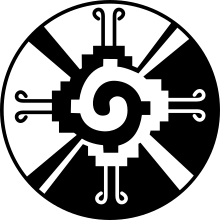Mexicayotl


Mexicayotl (Nahuatl word meaning "Essence of the Mexican", "Mexicanity"; Spanish: Mexicanidad; see -yotl) is a movement reviving the indigenous religion, philosophy and traditions of ancient Mexico (Aztec religion and Aztec philosophy) among the Mexican people.[1]
The movement came to light in the 1950s, led by Mexico City intellectuals, but has grown significantly on a grassroots level only in more recent times, also spreading to the Mexican immigrants to the United States.[2] Their rituals involve the (meaning “to be compelled by or said in dance; for a story to be told in an animated manner”).[3] The followers, called Mexicatl (singular) and Mexicah (plural), or simply Mexica, are mostly urban and sub-urban dwellers.[2]
History[]
The Mexicayotl movement started in the 1950s with the founding of the group Nueva Mexicanidad by Antonio Velasco Piña. In the same years Rodolfo Nieva López founded the Movimiento Confederado Restaurador de la Cultura del Anáhuac,[4] the co-founder of which was who in later decades became a spiritual leader of the Mexicayotl movement, endowed with the honorific Tlacaelel. He had a deep influence in shaping the movement, founding the In Kaltonal ("House of the Sun", also called Native Mexican Church) in the 1970s.[5]
From the 1970s onwards Mexicayotl has grown developing in a web of local worship and community groups (called calpulli or kalpulli)[2] and spreading to the Mexican Americans or Chicanos in the United States. It has also developed strong ties with Mexican national identity movements and Chicano nationalism.[6] Sanchez's Native Mexican Church (which is a confederation of calpullis) was officially recognised by the government of Mexico in 2007.[7]
See also[]
References[]
- ^ Yolotl González Torres. The Revival of Mexican Religions: The Impact of Nativism. Numen - International Review for the History of Religions. Vol. 43, No. 1 (Jan., 1996; published by: BRILL), pp. 1-31
- ^ a b c Susanna E. Rostas. Mexicanidad: The Resurgence of the Indian in Popular Mexican Nationalism. University of Cambridge, 1997.
- ^ Jennie Marie Luna. Danza Azteca: Indigenous Identity, Spirituality, Activism and Performance. San Jose State University, Department of Mexican American Studies. 2011
- ^ Lauro Eduardo Ayala Serrano. Tiempo Indígena: la construcción de imaginarios prehispánicos.
- ^ Tlacaelel Francisco Jimenez Sanchez biography. In Kaltonal, 2005.
- ^ Zotero Citlalcoatl. AMOXTLI YAOXOCHIMEH.
- ^ Religión prehispánica renace en el siglo 21. Vanguardia, 2008.
External links[]
- Chicano nationalism
- Indigenous Mexican American culture
- Indigenous nationalism in the Americas
- Indigenous peoples in Mexico City
- Indigenous politics in North America
- Mesoamerican mythology and religion
- Mexican nationalism
- New religious movements
- Religion in Mexico
- Religion in the United States